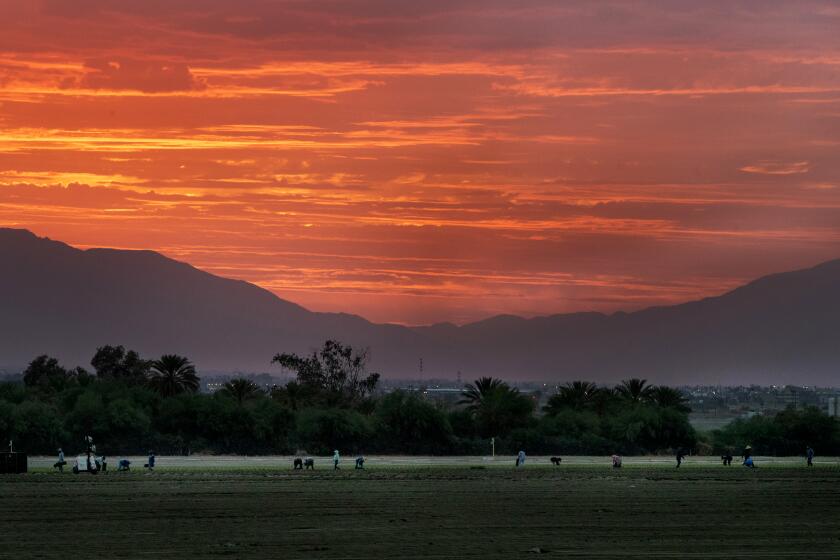
- Share via
The alarm bells are loud and clear.
Federal and international climate officials recently confirmed that 2023 was the planet’s hottest year on record — and that 2024 may be even hotter.
With a global average temperature of 58.96 degrees, Earth in 2023 was within striking distance of a dangerous limit: 2.7 degrees of warming over the preindustrial period, or 1.5 degrees Celsius, according to the European Union’s Copernicus Climate Change Service.
Aggressive and impactful reporting on climate change, the environment, health and science.
The benchmark is significant. In 2015, the United States was among 195 nations that signed the landmark Paris agreement, an international treaty drafted in response to the worsening threat of climate change.
The parties agreed to hold the increase in the global temperature to a maximum of 2 degrees Celsius over preindustrial levels — and preferably below 1.5 degrees Celsius — in order to reduce the worst effects of climate change.
The preindustrial period refers to an era before humans began to meaningfully alter the planet’s climate through fossil fuel and other heat-trapping emissions. Most agencies measure this using temperature data from between 1850 and 1900.
But last year’s simmering temperatures make it clear the 1.5-degree Celsius benchmark is slipping away.

“At this point, it is really difficult to see a path to keeping warming below 1.5 degrees,” said Kristina Dahl, a principal climate scientist with the Union of Concerned Scientists.
To do so, she said, would necessitate a more than 40% reduction in global greenhouse gas emissions by 2030.
“That requires a pace of emissions reductions that’s really inconsistent with what we see on the planet to date,” Dahl said. “At the same time, it’s really important that we continue to strive for that goal, even if we know we’re not going to make it.”
With a global average temperature of 58.96 degrees, the year was nearly one-third of a degree warmer than the previous hottest year on record, according to officials.
Critically, the limit set under the Paris agreement is not about a single day, month or even year of warming, Dahl said. Rather, it refers to sustained warming over two or three decades. (The agreement does not specify a time frame, and has been interpreted differently by different scientists.)
“Remember, passing this threshold as defined in the Paris Agreement is supposed to reflect when human-caused global warming consistently exceeds 1.5 degrees Celsius compared to preindustrial times,” the National Oceanic and Atmospheric Administration wrote in a recent report.
NOAA noted that global surface temperatures can be influenced not only by human-caused climate change, but also by natural climate factors such as El Niño and random weather, which can briefly push monthly or even yearly temperatures above the 1.5-degree Celsius threshold.
“To know when Earth has passed that threshold, we have to look at longer timescales,” the agency said.
What is clear, however, is that each additional degree — or even tenth of a degree — of warming will have impacts beyond those already occurring, including increased tree mortality, biodiversity loss, worsening wildfires, longer heat waves, extreme rainfall and heavy floods.
The tipping points include groundwater depletion, rising insurance costs, extreme heat, species extinction, melting glaciers and space debris.
In 2018, the United Nations Intergovernmental Panel on Climate Change released a special report on the 1.5-degree Celsius threshold that outlined a number of potential futures based on different levels of emissions reductions and subsequent warming.
In one middle-of-the-road scenario, delayed action around emissions leads the planet to experience a warmer decade in the 2020s before peaking at 2 degrees Celsius of warming around the middle of the century. The warming then begins to decrease due to improved global efforts and technology.
In that world, deadly heat waves would strike major cities such as Chicago, while droughts would plague southern Europe, southern Africa and the Amazon, the IPCC report says. The destruction of key ecosystems including coral reefs, tropical forests, mangroves and sea grass beds would lead to reduced levels of coastal defense from storms, winds and waves, and Asia and other places would experience major flooding.

That scenario also predicts that steadily rising sea levels, increased water stress and declining crop yields would put pressure on global food prices and lead to prolonged famines in some African countries. The world would also see increasing levels of public unrest and political destabilization, the report says.
Such possibilities illuminate the need for urgent action, as well as the consequences of a half-degree Celsius increase from 1.5 to 2 degrees of warming. For example, about 75% of the world’s coral reefs are expected to be lost at 1.5 degrees of warming, versus 99% at 2 degrees, Dahl said.
Antarctic ice sheets are also sensitive to that half degree, and would see exponential melting at 1.5 degrees Celsius and beyond. Their melting would be “a tipping point in Earth’s climate system that would be really difficult to recover from,” Dahl said.
Other differences include millions of additional people exposed to sea level rise, heat waves and water stress, according to a separate report from the U.K.-based group Carbon Brief, which compiled data from dozens of studies.
At 1.5 degrees Celsius of warming, the planet would soon see about 19 inches of sea level rise, a 16% increase in hot days and an 8% decline in Northern Hemisphere snowpack, the report says. But at 2 degrees Celsius, those numbers would increase to 22 inches of sea level rise, a 25% increase in hot days and an 11% decline in snowpack, among other effects.
Two degrees Celsius — or 3.6 degrees Fahrenheit — is the internationally agreed upon upper limit of warming established by the 2015 Paris climate agreement.
The current best estimate for when Earth will surpass the 1.5-degree benchmark is between now and 2040, according to the IPCC’s 6th climate change assessment, released last year.
Yet the planet is not only nearing that limit, it surpassed 2 degrees Celsius for the first time on record on two days in 2023 — Nov. 17 and 18, according to Copernicus.
Humanity has never before “had to cope with a climate this warm,” the agency’s director, Carlo Buontempo, said recently.
“There were simply no cities, no books, agriculture, or domesticated animals on this planet last time the temperature was so high,” Buontempo said. “This calls for a fundamental rethink of the way in which we assess our environmental risk, as our history is no longer a good proxy for the unprecedented climate we are already experiencing.”
In November, world leaders gathered in Dubai for COP28 — the same annual climate conference where the Paris agreement was established in 2015. At Dubai, nearly 200 nations agreed for the first time to move away from planet-warming fossil fuels.

Dahl, of the Union of Concerned Scientists, said it’s a step forward. What’s more, she said, it doesn’t necessarily matter where emissions reductions come from. While every country should do its part, places that are lagging can be bolstered by places that are making deeper cuts, such as California.
“If we, as a country, can recognize our culpability as being the world’s historically largest emitter, and really take the lead on aggressively reducing emissions, that will have a significant impact,” Dahl said.
Limiting sustained warming to below 2 degrees Celsius is still within reach, she added — so long as countries continue to strengthen and implement their pledges to reduce emissions.
“Every tenth of a degree really matters,” she said.
And while the 1.5-degree threshold is likely to be surpassed, it’s important to keep working toward it. Dahl likened it to getting her kids to school in the morning when they’re already running late — noting that it’s better to be late by one minute than one hour.
“That’s how I think of the 1.5 C goal,” she said. “At this point, it would be incredibly difficult to achieve that, and we have to keep trying.”
More to Read
Sign up for Essential California
The most important California stories and recommendations in your inbox every morning.
You may occasionally receive promotional content from the Los Angeles Times.















